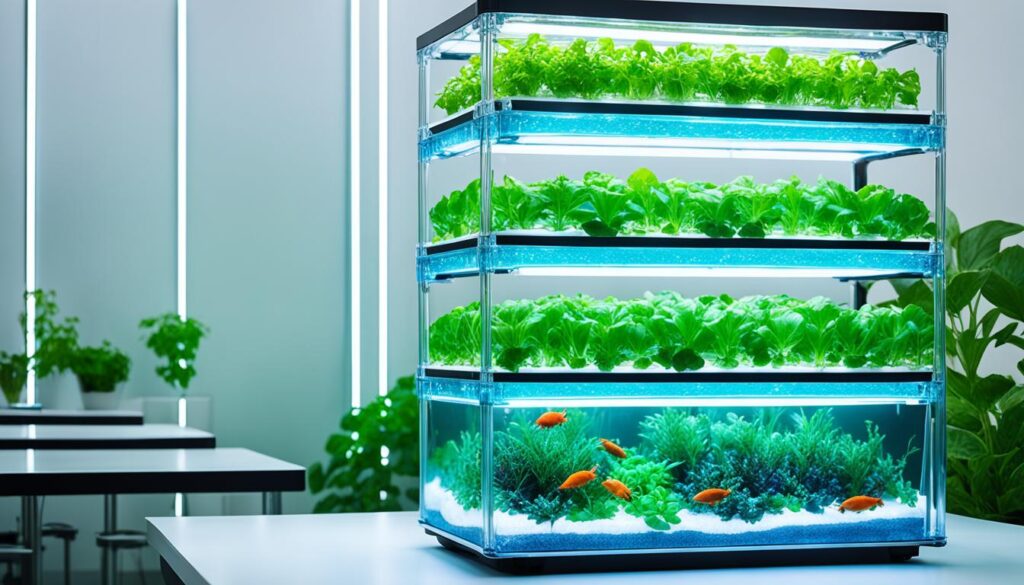The need for eco-friendly ways to grow food is growing. Vertical farming aquaponics use hydroponics and aquaculture together. They help deal with the lack of farm land. This method grows crops indoors. It uses less water and space. It’s also better for our planet than traditional farming.
There are three kinds of vertical farming: hydroponics, aeroponics, and aquaponics. Aquaponics is the mix of both. In this mix, plants eat the fish waste, cleaning the water for the fish. It makes a perfect circle to grow food. This way, you can grow a lot of different veggies and herbs.
Key Takeaways
- Vertical farming aquaponics combines hydroponics and aquaculture for sustainable food production in urban areas.
- Aquaponics integrates aquaculture (raising fish) and hydroponics (growing plants without soil) in a symbiotic ecosystem.
- Vertical farming allows for year-round production, reduced water and space needs, and environmental benefits.
- Aquaponic vertical farms can recycle up to 98% of water through natural filtration.
- Stacked vertical farming systems occupy 10-30 times less space than traditional farms for equivalent yields.
Understanding Vertical Farming Aquaponics
Vertical farming aquaponics uses a mix of aquaculture and hydroponics. It’s a closed system where fish and plants help each other. The fish waste feeds the plants, and the plants clean the water for the fish. This way, it’s possible to grow food like leafy greens and herbs. You can do this indoors or outdoors. The system includes fish tanks and growing beds connected by tubes for water flow.
Integration of Aquaculture and Hydroponics
In this system, fish and plants take care of each other. The fish waste is full of food for the plants. This waste goes to the plants, they grow. Then, the plants clean the water for the fish. This keeps everything in balance. It saves water and space, making it a good way to grow food.
Symbiotic Ecosystem for Fish and Plants
Vertical farming aquaponics can be made indoors with lots of light and control. Or, outdoors where it’s safe from harsh weather. Indoors, you can keep the perfect conditions, but it uses more energy for heaters or coolers. Outdoors, you save on energy but might need fans or covers. No matter where, using stacked beds makes the best use of space and grows more food.
Indoor and Outdoor Cultivation of Crops
Vertical farming aquaponics can be set up inside or outside. Inside, you control the weather conditions but use more power. Outside, you save on power but might need ways to stay the right temperature. Either way, using stacked beds helps grow lots of food in a small area.
Components of a Vertical Aquaponics System
A vertical aquaponics system has fish tanks and hydroponic grow beds. The fish tanks house fish like tilapia and catfish. The plants grow above in beds filled with gravel or clay. A network of tubing connects the tanks to the beds. This lets nutrient-rich water flow from the fish tanks to the plants for them to grow.
Fish Tanks and Hydroponic Grow Beds
The system keeps moving and reusing water. Pumps move water from the fish tanks to the grow beds. Then, the siphons send water back to the tanks. Filters clean the water, making it safe for the fish and plants. This way, almost all the water is used again. It’s a very efficient way to grow food, using much less water than usual.
Water Circulation and Recirculation
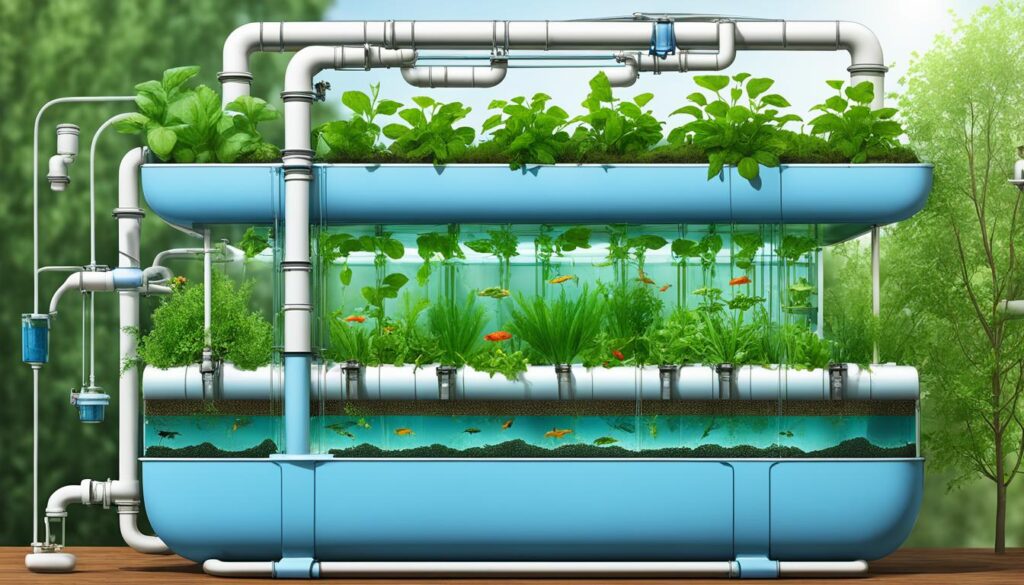
Suitable Fish and Plants for Vertical Farming Aquaponics
Tilapia is a great fish for vertical aquaponic farms. It is tough, can live in different water types, and helps plants grow strong. Catfish are also good because they share these benefits. Koi need more space to grow, but their waste can still help plants. Choosing the right fish considers how much they waste and what plants they help best.
Common Fish Species for Aquaponics
In aquaponics, fish water feeds leafy greens, herbs, and veggies well. This includes lettuce, kale, Swiss chard, bok choy, and herbs like basil and mint. These plants grow quick and are ready to eat soon. They match well with the fish waste, which is full of nutrients these plants need.
Leafy Greens and Herbs for Hydroponic Growth
Not just leafy greens and herbs, but also fruits like tomatoes and peppers grow well. They need more care, like watching the water’s pH and temperature. To help them grow strong, they might need extra support to stand up straight. With a little extra work, a variety of greens and fruits can grow in aquaponics.
Fruiting Plants in Aquaponic Systems
| Plant Types | Nutrient Requirement | pH Requirement | Temperature | Growth Rate |
|---|---|---|---|---|
| Leafy Greens | Low | 6.0 to 7.5 | 45°F to 75°F | Rapid |
| Herbs | Low | 5.5 to 7.0 | 65°F to 85°F | Rapid |
| Fruiting Plants | Varying (High for Tomatoes, Cucumbers) | 5.5 to 6.5 | 60°F to 85°F | Slower |
Matching the right fish with the plants is key for a healthy aquaponics system. Plants should use the fish’s waste well and be strong in water. They need solid roots to pull in nutrients and keep the water steady.
The design of the aquaponic system also matters for plant choice. Systems with growing media can hold more plants. Raft systems do best with plants that don’t need a lot of space, like lettuce. Also, think about how much sun the growing area gets when picking plants.
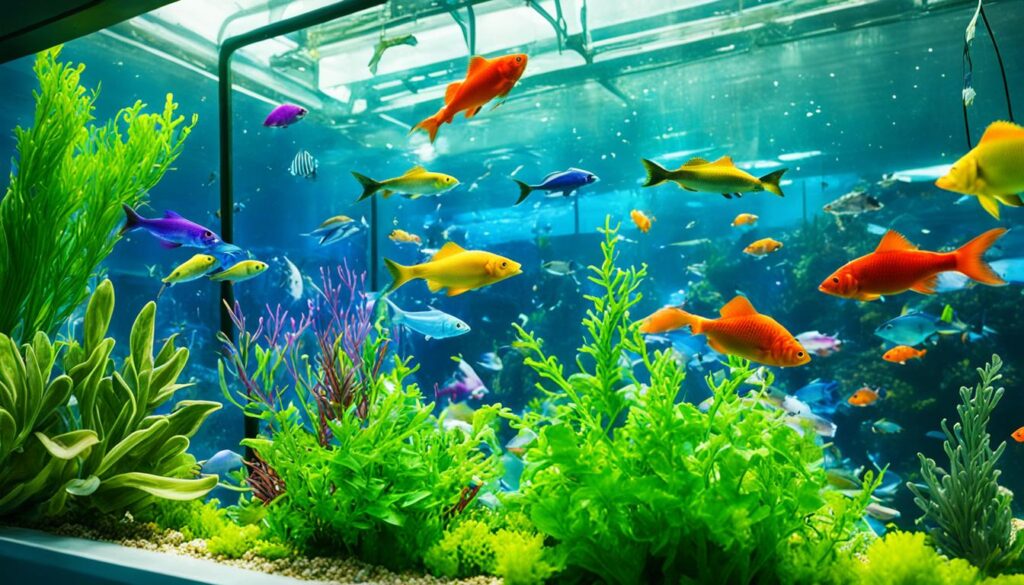
Benefits of Vertical Farming Aquaponics
Aquaponics with vertical farming can give more food from a smaller space. For example, a tall farm growing lettuce can give as much as 30 normal farms. This is because you can harvest fish and grow plants all the time. This way, you get a lot more food from the same area. These are the big pluses of using vertical farms for growing food.
Year-Round Production
With vertical aquaponics, you can grow food all year, no matter the weather. You control everything inside, like the light and the temperature. This means you can have many different plants at once, all growing well. It makes growing food really efficient.
Reduced Water and Space Needs
Aquaponics only use a little water because it gets reused. It’s much better than just hydroponics. With aquaponics, you don’t need a lot of water. And, because crops grow on top of each other, it doesn’t need much space. This saves water and land, good for places with not much of these.
Environmental Friendliness
Aquaponics use no pesticides and don’t need heavy machines. This makes the air cleaner and reduces global warming. They also use less land and water. So, they keep the environment healthier, making food in a way that’s better for the earth.
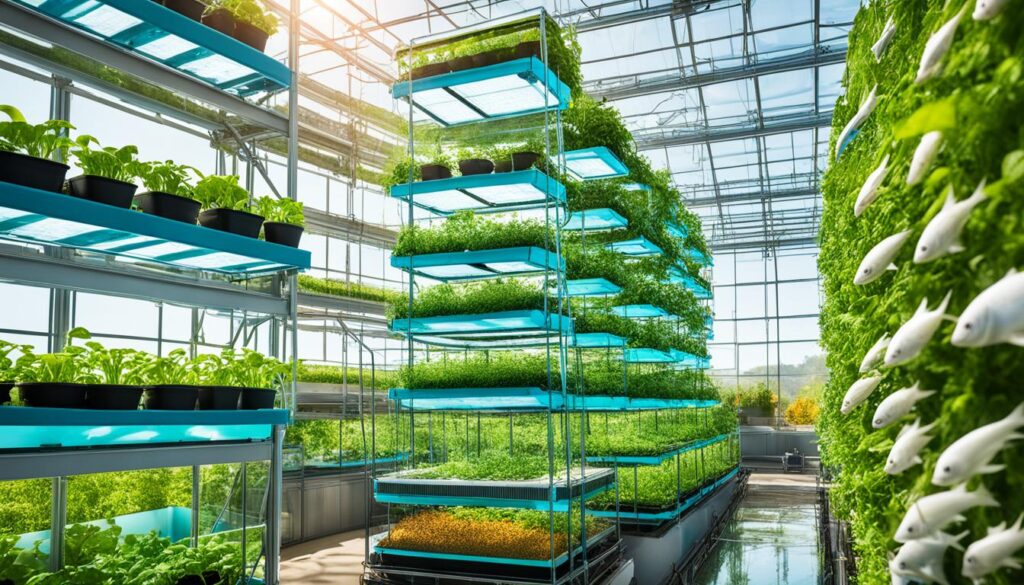
Vertical Farming Aquaponics Systems
Vertical farming aquaponics systems are built for growing inside or outside. Indoor setups let you control things like warmth, dampness, and light. But, they need more power to manage the climate. Outdoor versions are less costly to run. However, you need to watch the temperature and protect from bad weather. The choice between inside and outside systems depends on space, the weather, and your power supply.
Components: Tanks, Pipes, and Grow Beds
These systems have fish tanks, grow beds, and a sump. Fish tanks can be rectangle or round and are on stands. They are filled with fish that are good for aquaculture. Above them, there are grow beds made from wood, metal, or hard plastic. These hold the material the plants grow in, like gravel. Pipes connect everything. They move the water with nutrients from the fish tanks to the grow beds and back.
Water Pumps and Filtration
Water pumps move the water up through the system in these setups. Filters clean the water from the fish tanks. This takes out solid bits and bad stuff in the water. It keeps the water right for the fish and plants. Some systems also use UV light to stop algae and germs. Clean, moving water is key for a healthy aquaponics setup.
Temperature and Lighting Controls
In indoor systems, keeping the right temperature and light is very important. Heaters and fans control the air and water temperatures. Lights help the plants grow by giving them what they need. Timers and sensors make sure everything runs without you having to do it all the time. This keeps the fish and plants in good shape in the closed space.
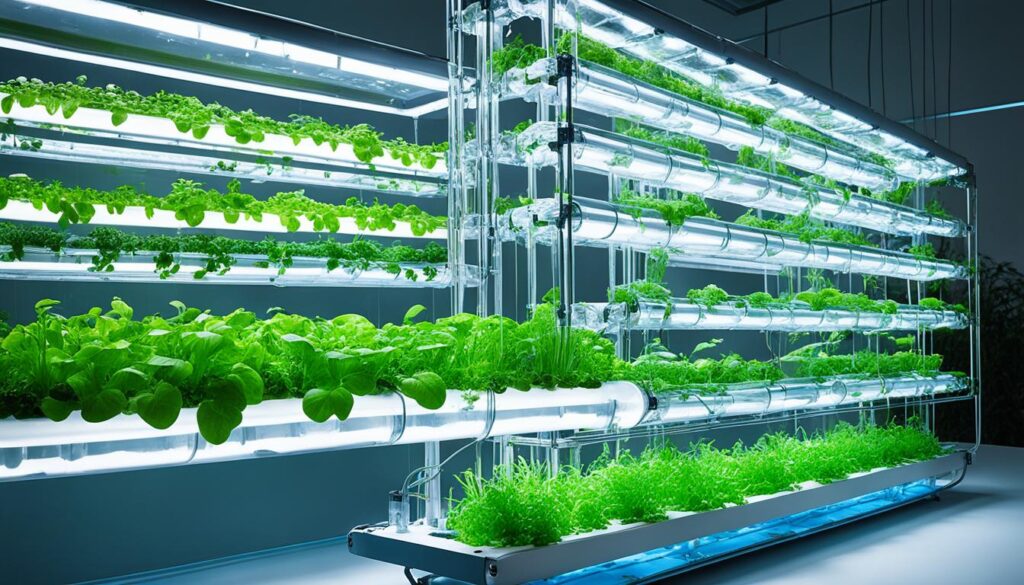
Conclusion
Vertical farms with aquaponics are getting more important. They use new tech to grow plants better. This helps use resources wisely and makes more food.
They grow many types of plants all year in small city areas. They use less water and help the planet. This way, we can have healthy food close to home. Aquaponic farming is growing fast and becoming popular for saving the earth.
The future of aquaponic vertical farming is shining with hope. It’s becoming a big market quickly. It can grow more food, use less water, and protect our world. This is key for food safety around the world today.

